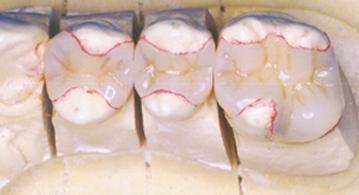
25 minute read
ChaPTer 12 Prosthodontics
Chapter
12 Prosthodontics
Advertisement
Objectives Upon completion of this chapter, the reader should be able to identify and understand terms related to the following: 1. Divisions in the field of prosthodontics. Examine the requirements for prosthodontic care, and define the terms prosthesis of fixed and removable prosthodontic appliances. 2. Types and characteristics of prosthodontic materials. Describe the assorted materials used in prosthesis construction and their characteristics. 3. Fixed prosthodontics. List and describe the function or purpose of the various types of fixed prosthodontics. 4. Removable dental prostheses. Define and describe the function or purpose of the various components used in removable dental prostheses. 5. Procedures and methods used in prosthodontic practice. Name and describe the various procedural steps and methods used to complete construction of fixed and removable dental prostheses. 6. Use of implants in prosthodontics. Discuss the various types of dental implants and their necessity in dental prostheses application. 7. Miscellaneous prosthodontic services. Describe additional devices and the conditions they are used to treat.
Divisions in the Field of Prosthodontics
Prosthodontics is one of the nine recognized specialties of the ADA. A licensed graduate of dentistry is permitted to perform dental treatment in this area. Some dentists pursue post-graduate studies in this art, and others will complete the three extra years of training to be ABP (American Board of Prosthodontics) certified and limit their practice to prosthodontics. A few will continue with yet another year of maxillofacial prosthetic training in correction of birth defects, TMJ disorders, cancer destruction, traumatic disfigurement, and difficult cases and obtain fellowships as maxillofacial prostheses specialists.
A prosthesis (prahs-THEE-sis; plural = prostheses) is a replacement for a missing body part. In the dental field, it may be a fixed or removable appliance that replaces removed or nonerupted teeth. A fixed appliance, such as a cemented crown, is placed in the mouth and is not intended for removal. A removable appliance is placed in and out of the mouth at the patient’s will. Implantology, the science of dental implants, involves the use of both fixed appliances and removable appliances in some instances.
Assorted materials are used in the construction and repair of prostheses. Among the synthetic and precious or semi-precious metals used for appliance fabrication are: noble metals: the valuable alloys—gold (Au), palladium (Pd), platinum (Pt), and silver (Ag). base metals: chromium-cobalt or chromium nickel, which may be used alone or in a mixture with noble alloys. These alloys are further classified for insurance purposes as high noble, noble, and base according to their formulas: high noble alloy: contains more than 60% of gold, palladium, and/or platinum (with at least 40% gold). noble alloy: contains more than 25% of gold, palladium, and/or platinum. base metal alloy: contains less than 25% of gold, palladium, and/or platinum. porcelain (PORE-sih-lin = hard, translucent, ceramic ware): shells, veneer covers, or facings fused to the surface of a metal crown to give the appearance of a natural tooth surface; often abbreviated PFM (porcelain fused to metal). composite: resin material used for tooth-colored replacement. acrylic (ah-KRIL-ick): synthetic resin material used in fabrication of appliance parts, as coverings for the metal frameworks, or as natural tissue replacement. ceramic: a hard, brittle material produced from nonmetallic substances fired at high temperatures; supplied in block shape for milling into crown and tooth forms. titanium: corrosion-resistant, lightweight, strong bio-compatible metal used in dental implants and posts. zirconia (ZrO2): corrosion resistant, bio-compatible material, similar to titanium; used for implants.
The choice of which material to use for an appliance depends on the characteristics of that material relevant to prostheses construction. Associated terms are: hardness: ability of a material to withstand penetration. tensile (TEN-sill) strength: capability of a material to be stretched.
elasticity (ee-las-TISS-ih-tee): ability of a material to be stretched and then resume its original shape. ductility (duck-TILL-ih-tee): ability of a material to be drawn or hammered out, as into a fine wire, without breaking. malleability (mal-ee-ah-BILL-ih-tee): ability of a material to be pressed or hammered out into various forms and shapes. elongation (ee-long-GAY-shun): ability of a material to stretch before permanent deformation begins.
Fixed Prosthodontics
Various fixed prosthodontic appliances are used in mouth restoration, from the singular crown to a full arched bridge. Related terms are: inlay: a solid-casted, or milled restoration, involving some occlusal and proximal surfaces, which is cemented into a tooth preparation (see Figure 12-1A). onlay: a solid-casted or milled restoration that covers some occlusal tooth cusp and side wall area and is cemented onto a prepared site (see
Figure 12-1A). crown: a fabricated, tooth-shaped cover replacement for a missing crown area that is cemented onto the remaining prepared crown surfaces. Some of the types of crowns used in dentistry are: full crown: cast metal, tooth-shaped cover that replaces the entire crown area. Acrylic resin crowns may be used as a temporary crown cover during treatment. jacket crown: thin, preformed, metal shield used to cover a large area of anterior crowns; can be gold metal or metal covered with porcelain material to resemble tooth enamel. dowel crown: full crown cover with dowel pin extending into the root canal of a pulpless tooth; usually positioned on anterior teeth. three-quarter crown: similar to full crown, covering all of the crown except the facial surface of the tooth, which remains intact to present an esthetic, natural appearance. porcelain-fused-to-gold (PFM): crown that has a complete capping of metal base with fused porcelain to metal, giving tooth contour, shape, and cover. veneer: A direct veneer is placed and cured directly on the tooth surface to build up the area or to replace a missing tooth structure. For an indirect veneer, tooth material is prepared in the lab and later cemented onto the tooth structure. Figure 12-1B shows a before and after view of veneers of the anterior teeth.
Crown replacement and restorations may stand alone or may also be part of fixed bridgework. A bridge is a prosthesis used to replace one or more teeth. Dental bridgework may be of a fixed or removable nature. Figure 12-2 gives illustrated examples of bridges.
(A)
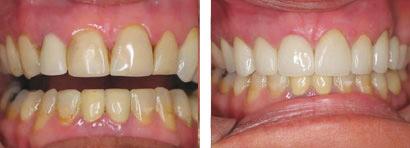
(B)
Figure 12-1
(A) Laboratory preparation of two inlays on premolar teeth and a distal onlay on the molar tooth. (B) Before and after example of laminated veneers on the anterior crowns.
Courtesy of ROE Dental Labs
fixed bridge: cemented into the oral cavity and not removed by the patient; the number of teeth involved in the appliance determines the amount or number of units (Figure 12-2A). cantilever bridge (KAN-tih-lee-ver): bridge with unsupported end, usually saddled (Figure 12-2C). Maryland bridge: replaces anterior or posterior tooth and is cemented directly to the adjacent or abutting teeth; also may be called a California bridge or resin-bonded bridge (Figure 12-2D). A bridge has three components or structural parts. = pontic (PON-tick): artificial tooth part of the bridge that replaces the missing tooth and restores function to the bite. = abutment (ah-BUT-ment): natural tooth (or teeth) that is prepared to hold or support the retaining part of the bridgework in position. = adjacent (ah-JAY-cent = nearby or adjoining) teeth: may be included in units if they are involved in the bridge area.
Abutment Retainer Pontics Connector
R F Occlusal Load
(A) Four-Unit Permanent Bridge (B) Removable Bridge (C) Cantilever Bridge/Cantilever Partial Denture
(D) Maryland Bridge (E) Bridge with a Post Abutment
Composite onlay Composite inlay
Figure 12-2
Illustrated examples of bridges
Removable Dental Prostheses
Prostheses that the patient can take in and out at will are called removable prostheses. These devices include full mouth dentures, as well as a replacement for single teeth. Terminology includes the following: complete denture (DENT-chur = removable appliance composed of artificial teeth set in an acrylic base): full denture designed to replace the entire dentition of an upper or lower arch. partial denture: removable appliance, usually composed of framework, artificial teeth, and acrylic material; replaces one or more teeth in an arch. immediate denture: denture prosthesis that is placed into the mouth at the time the natural teeth are surgically removed. overdenture: prosthetic denture that is prepared to fit and be secured on implant posts or on prepared retained roots.
Although all removable appliances are constructed to fit in a designated area and to return the mouth to a proper function, not all are fabricated in the same manner or using the same materials or components such as: framework: metal skeleton or spine onto which a removable prosthesis is constructed.
saddle: the part of the removable prosthesis that strides or straddles the gingival crest; used to balance the prosthesis and serves as a base for the placement of artificial teeth. rests: small extensions of the removable prosthesis made to fit or sit atop the adjoining teeth; provide balance and stability for the partial denture appliance. Rests are named for the area that is in contact with the tooth surface—occlusal, lingual, incisal, and so on. clasp: extension of partial framework that grasps the adjoining teeth to provide support and retention of the prosthesis. retainer (ree-TAIN-ur): in fixed prosthesis, the part of the appliance that joins with the abutting, natural tooth to support the appliance, like the pillar holding the span of a bridge over the water. Some retainers are thin bars extending from quadrant to quadrant, called lingual bars or some may be palatal bars. connector (kahn-ECK-tore = device used to unite or attach two or more parts together): used to connect quadrants of a partial denture or connect and support an overdenture. stress breaker: a connector applied in stress-bearing areas to provide a safe area for stress relief and possible breakage. artificial teeth: anatomical substitutes for natural teeth; made of porcelain or acrylic material in various shades and shapes, called molds. denture base: acrylic part of the denture prosthesis that substitutes for the gingival tissue. flange (flanj): projecting rim or lower edge of prosthesis. post dam: posterior edge of the maxillary denture; helps to maintain the denture and suction.
The structural components of dental appliances used in removable prostheses described in this section are illustrated in Figure 12-3.
Rest
Clasp Rest
Saddle
Figure 12-3
Removable partial denture with structural components noted
Palatal bar (Connector) Clasp
© Cengage Learning 2013
Procedures and Methods Used in the Prosthodontic Practice
Impression Procedure
Many of the operative procedures for fixed and removable prosthodontic appliances are similar in nature, with a few variations or step changes. Table 12-1 compares the operative steps for fixed and removable prostheses. The discussion of prosthesis fabrication is concluded in Chapter 19, Dental Laboratory Procedures.
Throughout the prosthodontic appointment, various impressions of the teeth and tooth preparations are taken. The choice of material to be used and the necessary items required for the procedure depend on the reason for the treatment and the condition or physical properties of the item to receive the impression. Impression materials must be elastomeric (ee-las-toh-MARE-ick = having properties similar to rubber), to be pliable during the impression process. Elastic impression items include hydrocolloids, rubber bases, and compounds. All materials must be carried and applied in the mouth by use of specially designed trays. Hydrocolloids
An impression material that is both reversible and irreversible is hydrocolloid (high-droh-KOHL-oyd; hydro = water, colloid = suspension of material), an agar-like material that can change from one form to another. The types of hydrocolloid are: reversible hydrocolloid: impression material that can change from solid or gel state, to a liquid form and back again, depending on temperature changes.
This material is used in a water cooled tray. thermoplastic (therm-oh-PLAS-tick; thermo = heat, plastic = movable): quality of a material that changes from a rigid to plastic or movable form as a result of application of heat. irreversible hydrocolloid: quality that, once chemically set or in gel form, this material cannot be reversed or used again. An example of an irreversible hydrocolloid is alginate (AL-jih-nate) powder that is supplied in bulk containers or individual envelopes in regular or fast-set times. Alginate is stored in a dry, cool place until mixed with a premeasured water dose. Humidity can affect the water balance and stability of an irreversible hydrocolloid.
Swelling from absorption of water is called imbibition (im-bih-BISH-un = fluid absorption), and evaporation or fluid loss causes shrinkage.
Table 12-1 Comparison of Operative Steps for Dental Prostheses*
Fixed Prosthodontics Removable Prosthodontics
Exam, shade, mold selection, impression Preparation of tooth and/or site Impression of prepared tooth/site Try-in, unit adjustment Same procedure Mouth preparation, surgical adjustment Multiple impressions—custom trays Try-in, wax adjustment
Rubber Bases
Rubber bases are common impression materials. They exhibit rubberized characteristics and are supplied in tubes, wash, and putty consistency or in a twincartridge (base and accelerator/activator), calibrated mixing dispenser called an extruder (ecks-TRUE-dur) gun. The base mixture requires an activator or catalyst (CAT-ah-list = substance that speeds up a chemical reaction) to instigate mixing together into a homogeneous mass and chemical set. The basic types of rubber bases are silicone (SILL-aih-kone), polyether (pohl-ee-EE-thur), polysulfide (pohl-ee-SUL-fide), and polyvinylsiloxane (pohl-ee-vine-uhl-sil-OX-ain). Compound
Another thermoplastic impression material is compound (CAHM-pound), a nonelastic impression material that may be used in edentulous impressions. Compound is supplied in cakes or blocks and is heated to a soft, pliable mass; placed in an impression tray; and put into the mouth. After cooling in the mouth, it is removed, further cooled, and used as a customized impression tray for a future final wash with a zinc-oxide-eugenol paste or impression paste material. Impression Trays
Dental impressions of the mouth are accomplished by placing the desired material into a carrying device and inserting it into the patient’s oral cavity. The specific device used to transport the impression material depends on the site to be reproduced. Impressions can be of one tooth, a few teeth, or an entire edentulous (ee-DENT-you-luss = without teeth) arch. Some transport devices are copper tubes. Some are trays of stock metal or plastic purchased through dental suppliers. Trays may be custom constructed or purchased as full arch, quadrant, or sectional and anterior trays. Impression trays come in various sizes and shapes to accommodate specific areas of the mouth. Figure 12-4 shows a few examples. Impression materials are discussed further in Chapter 18, Dental Laboratory Materials.
Figure 12-4
Impression trays can be smooth surfaces, rim-locked style, or with holes to help hold in the materials.

© Cengage Learning 2013
Preparation of Teeth and Site
Site preparation must be accomplished before a prosthesis can be placed. The teeth and the area involved could receive one or a combination of a variety of preparations: alveolectomy (al-vee-oh-LECK-toe-mee): surgical removal of alveolar bone crests; may be required to provide smooth alveolar ridge for denture seating. alveoplasty (al-vee-oh-PLASS-tee): surgical reshaping or contouring of alveolar bone. extraction (ecks-TRACK-shun): surgical removal of teeth may be necessary. If completed before the insertion of an immediate denture, a clear template (TEM-plate = guide or pattern) may be used as a guide to prepare the alveolar surface. coping (KOH-ping = coverings): metal cover placed over the remaining natural tooth surfaces to provide attachments for overdentures. reduction (ree-DUCT-shun = reducing or lessening in size): removal of tooth decay and surfaces to receive the appliance. Various margin edges are prepared on the natural tooth to accommodate the thickness and material of the covering artificial crown, as illustrated in Figure 12-5. chamfer (SHAM-fur = tapered margin at tooth cervix): preparation for crown placement or full veneer covering. shoulder (SHOAL-dur = cut gingival margin edge): preparation to provide junction of the crown and tooth; usually for metal on ceramic crown or porcelain jacket crown. bevel (BEV-el = slanted edge): tooth preparation for seating and holding of a crown. core buildup: use of synthetic material to enlarge tooth core area to provide support for an artificial crown and to protect the pulpal tissues. Small brass pins may be inserted into the material to aid retention and strength.
Preparations at the gingival margin
Crown
Prepared tooth
Figure 12-5
Tooth margins for various types of preparations

Preparation at gingival margin
Chamfer preparation Shoulder preparation Beveled shoulder preparation
post placement: addition of a metal retention post to teeth that have had pulp removal and root canal enlargement, to aid in stability and strength (see
Figure 10-3 in Chapter 10, Tooth Restorations). undercut: removal of tooth structure near the gingival edge to provide a seat or placement for the extending edge of the appliance; same as tooth reduction. retraction cord: chemically treated cord placed in the gingival sulcus to obtain chemical or physical shrinking of the attached gingiva. These twisted or braided cords are plain or impregnated (im-PREG-nay-ted = saturated) with chemicals and packed into the gingival area to cause temporary shrinkage of the surrounding tissue and/or control bleeding (see Figure 12-6).
Another method is to eject retraction paste into the sulcus prep for one to two minutes and then rinse away prior to impression taking. bite registration: impression of the teeth while in occlusion. A bite registration is taken to assist with the fabrication of the prosthesis. The impression may be obtained from biting into a wax sheet, bite plates, or stock trays and prepared frames filled with impression material. Some dentists will eject impression material on the surfaces of the teeth to make a bite pattern for later use. Bite registrations may be classified in various ways. open-bite: patient bites into the impression material. closed bite: the material is injected and expressed around the desired teeth while they are in occlusion. opposing arch: impressions of the occlusal surfaces of both arches are taken in the same procedure. work order: written directions from the dentist to the laboratory completing the case; the impressions, bite registration, and orders are sent together. temporary or provisional coverage: temporary protection for the prepared tooth while laboratory work is being completed. Coverage may be in form of an aluminum cap, acrylic custom cover, or preformed resin crown form cemented onto the prepared teeth for protection until the final try-in and delivery.
Figure 12-6
Retraction cord placement on a model

© Cengage Learning 2013
Try-In, Adjustment, and Delivery
During the preparation, construction, and delivery of the dental prosthesis, the patient will return for various appointments. Some visits require adjustment and recordings of measurements that will be sent to the laboratory to assist in final fabrication. Related terms include the following: seating: placement and fitting of appliance for try-in and final cementation.
Patient bites on a stick or device, applying pressure for the application of the crown or prosthetic item. condylar inclination (KHAN-dih-lahr = pertaining to the condyle) (in-klih-NAYshun = tendency, bending, bias): observation of bite relationship and TMJ involvement. The following articulation movements involve the condyle: centric (SEN-trick = central, center): occurring when the condyle rests in the temporal bone during biting, resting, and mouth movements. protrusion (pro-TRUE-shun = projecting or thrust forward): measurement with the mandible thrust forward, with the lower jaw out. retrusion (ree-TRUE-shun = forcing backward): measurement with the mandible drawn backward. lateral excursion (LAT-er-al = side, ecks-KERR-shun = movement): measurement with side-to-side movement of the mandible. appearance indicators: notations of the smile line and the length of the cuspid point.
Use of Implants in Prosthodontics
When prosthodontic appliances do not fit properly or are difficult to retain in the mouth, the dentist may suggest titanium or zirconia implants to provide stabilization and retention. There are different types of implants, and each is used in a specific area, depending on available bone, type, and amount of stabilization needed. The related terms are: implant (IM-plant = insertion of object): surgical insertion of implant posts or prepared frame to provide stabilization for overdentures or appliance retention. Some implants may be a simple single insertion while others may be complicated and require study and preplanning such as CAD/CAM impression, cone beam radiograph measurements, and preconstruction of placement guides as shown in Figure 12-7. A surgical implant may be one or a combination of the following types: root form implant—endosseous (en-DOSS-ee-us = within the alveolar bone): screw-type device that is cemented or threaded into the mandible or maxilla bone; used for a single tooth or post implant. plate form implant: used for narrow jawbone; flat-plate style. subperiosteal (sub-pear-ee-OSS-tee-ahl = under the gingival and alveolar tissues): implant plate or frame is placed under the periodontium and stabilized on the mandibular bone. It is used when bone height or width is insufficient; rests on top of the bone.
Figure 12-7
Example of surgical guide for implant placement.
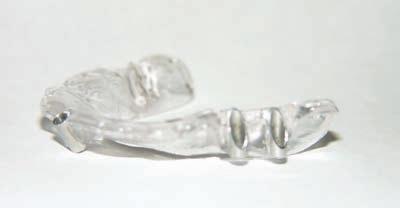
Courtesy of ROE Dental Lab
transosteal (trans-OSS-tee-ahl = through the mandibular bone): large plate is stabilized on the lower border of the mandibular bone with posts extending through the gingiva; used to anchor prostheses in difficult situations.
All transplant appliances must bond with the bone tissue to obtain stability. This process is called osseointegration (osseo = bone, integrate = bonding) and requires from three to six months to occur.
Miscellaneous Prosthodontic Services
There are a variety of prosthodontic devices and treatments that can be rendered by the dentist or prosthodontist, depending on the operator’s expertise. Figure 12-8 shows a few. Terms related to these services are: maxillary obturator (ob-two-RAY-tore = body cavity obstruction): palatal cover device worn in the mouth to cover genetic openings into the nasal area, such as a cleft palate. TMJ adjustors: calibrated position splints for wear adjustment to maintain proper vertical dimension of occlusion. sleep apnea and anti-snore forms (mandibular advancement splint): custom-made dental-positioning device for tongue and mouth position during sleep period to avoid tongue drop and oxygen cutoff (see
Figure 12-8A). positioners: individual patient devices to maintain mouth or tooth position or to complete orthodontic positioning (see Figure 12-8B). sport mouth guards: custom-made semi-hard forms to be inserted in times of contact sports; may be space-adjusted for orthodontic brace wear (see
Figure 12-8C). repair and adjustment of devices: broken dentures or those with teeth missing, lost treatment trays, adjusted movement devices, and various prosthodontic appliances may be repaired or reconstructed by the skilled prosthodontist or prosthodontic technician.

(A) (B)
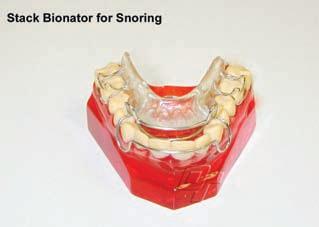
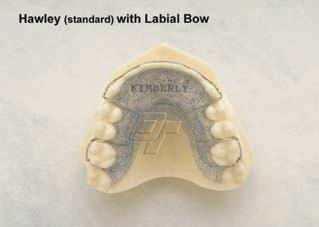
(C) (D)
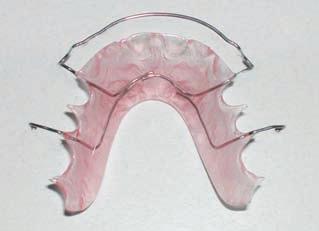
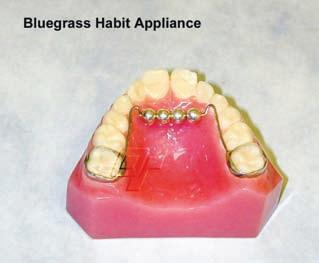
(E)
Figure 12-8
Assorted prosthetic devices: (A) bite adjuster/positioner, (B) anti-snore appliance, (C) Hawley orthodontic retainer, (D) removable orthodontic retainer, (E) habit supressor.
Review Exercises
Matching
Match the following word elements with their meaning. 1. ____ veneer A. implant metal 2. ____ acrylic B. thin surface shell or layer applied to tooth surface 3. ____ abutment C. mandible drawn backwards 4. ____ titanium D. claw-like framework extension to grasp teeth 5. ____ retrusion E. hard, translucent ceramic shell or cover material 6. ____ pontic F. resin material used in denture gingiva fabrication 7. ____ amalgam G. natural tooth used to support bridgework retainer 8. ____ alginate H. projecting rim or lower edge of denture or saddle 9. ____ obturator I. ability of material to stretch and return to shape 10. ____ protrusion J. mandible projecting forward 11. ____ ductility K. ability to be drawn out into thin line without breaking 12. ____ clasp L. part of bridgework replacing missing tooth/teeth 13. ____ porcelain M. body cavity obstruction 14. ____ flange N. base metal or combination of metals 15. ____ elasticity O. hydrocolloid that is irreversible
Definitions
Using the selection given for each sentence, choose the best term to complete the definition. 1. A full mouth maxillary denture is an example of what type of prosthesis? a. fixed b. removable c. immediate d. compound 2. A measurement taken with the mandible drawn back in occlusion is considered: a. centric b. protrusion c. retrusion d. lateral 3. An impression of the bite while the teeth are in occlusion is termed: a. centric bite b. protrusion bite c. closed bite d. open bite 4. A solid, cast restoration fabricated to fit into a prepared tooth is called a/an: a. inlay b. onlay c. crown d. composite 5. A thin-layered sheath to be placed over the surface of a tooth is a/an: a. taper b. bridge c. veneer d. jacket 6. An alloy of less than 25% of gold, palladium, and platinum is said to be: a. high noble alloy b. base noble alloy c. noble alloy d. semi-noble alloy 7. Aluminum caps, preformed crowns, and custom crowns used between appointments are: a. permanent coverage b. try-in applications c. temporary coverage d. restorations 8. A natural tooth used to support and become part of a fixed bridge is called a/an: a. restoration b. adjacent c. aperture d. abutment 9. Side-to-side movement of the mandible is which of the following movements? a. protrusion b. lateral c. retrusion d. centric
10. Retraction cord saturated with a chemical to resorb tissue is said to be: a. impregnated b. medicated c. resorptive d. regulated 11. A denture prosthesis placed in the mouth at the time of tooth removal is called a/an: a. overdenture b. partial denture c. immediate denture d. Maryland bridge 12. A hard, translucent, nonmetallic block material used in milling crowns and inlays at chairside is a/an: a. composite b. ceramic c. acrylic d. amalgam 13. The ability of a material to withstand penetration is an example of: a. hardness b. ductility c. tensile strength d. elasticity 14. The ability to be hammered or pressed into shape is an example of: a. elasticity b. elongation c. ductility d. malleability 15. The part of a partial denture that straddles the alveolar crest and gives support is a: a. saddle b. retainer c. clasp d. rest 16. The lower edge of a denture is called the: a. oblique ridge b. rest c. post dam d. flange 17. The posterior edge of the maxillary denture used to maintain position and suction is the: a. retainer b. denture base c. flange d. post dam 18. The term for a human dentition containing no teeth is: a. edentulous b. abutting c. undentated d. furnicated 19. A full gold crown with a porcelain facing is considered which type of prosthodontia? a. fixed b. removable c. immediate d. complete 20. A prosthesis constructed to fit over and attach to anchor post in the alveolar bone is a/an: a. immediate denture b. composite denture c. overdenture d. Maryland bridge
Building Skills
Locate and define the prefix, root/combining form, and suffix (if present) in the following words: 1. hydrocolloid prefix ___________________ root/combining form ___________________ suffix ___________________ 2. edentulous prefix ___________________ root/combining form ___________________ suffix ___________________ 3. implantology prefix ___________________ root/combining form ___________________ suffix ___________________ 4. alveolectomy prefix ___________________ root/combining form ___________________ suffix ___________________ 5. subperiosteal prefix ___________________ root/combining form ___________________ suffix ___________________
Fill-Ins
Write the correct word in the blank space to complete each statement. 1. A/an _______________________________ is a prosthetic device used to replace the missing teeth of an entire arch.
2. A machine that holds two materials, unites them, and expresses one mixed material is a/an _______________________________ syringe. 3. The acrylic crown cover placed on the prepared tooth between visits is called _______________________________ coverage. 4. ________________________ is the taking on or absorption of moisture by alginate material. 5. To provide support and aid retention in a large prep of a nonvital tooth, a/an ___________ may be placed and cemented into the enlarged nonfunctional root canal. 6. A/an _________________ is a material or chemical that enables or quickens the chemical reaction. 7. A mouth without teeth present is said to be _______________________________________. 8. The process of gross removal of tooth structure during a crown prep is called _______________. 9. A/an ______________ is a slanted-edge prep of a tooth being prepared for a crown. 10. The prosthodontic closing of a cleft palate area is called a maxillary _______________________. 11. A ______________________ bridge is unsupported on the end and may be replaced with the saddle part of the appliance. 12. A registration of a bite while the lower jaw is relaxed is a/an _________________ impression. 13. A prescription describing desired labor that is sent to the lab with the impressions is called a/ an ___________________________. 14. Another name for the metal skeleton of an appliance is the _______________ of the device. 15. A tapered margin at the tooth cervix placed in preparation for a crown space is a/an ___________________________ reduction. 16. An extension of bridge framework that sits on the occlusal surface to support and stabilize the bridge is called a/an ______________________. 17. A claw-like extension of a bridge that encircles a natural tooth and aids in retention of a crown is called a/an ____________________________. 18. A full cover resembling the natural shape of the tooth that is placed over a large preparation is called a/an ______________________________. 19. A ___________________________ appliance is a prosthetic device cemented into the mouth. 20. A resin material that may be used in the core buildup of a tooth is ______________________.
Word Use
Read the following sentences, and define the boldfaced word. 1. The proportions for the base and catalyst must be accurately measured for a good mix.
________________________________________ 2. To prevent shrinkage, the alginate impression should be poured up immediately.
________________________________________ 3. The assistant placed the work order for the repair of the prosthesis into the laboratory box.
________________________________________ 4. The condition of the adjacent teeth is important when preparing tooth replacement.
________________________________________ 5. Always replace the lid of the alginate container to prevent imbibition to the material.
Audio List
This list contains selected new, important, or difficult terms from this chapter. You may use the list to review these terms and to practice pronouncing them correctly. When you work with the audio for this chapter, listen to the word, repeat it, and then place a checkmark in the box. Proceed to the next boxed word, and repeat the process. abutment (ah-BUT-ment) acrylic (ah-KRIL-ick) adjacent (ah-JAY-sent) alveolectomy (al-vee-oh-LECK-toe-me) alveoplastomy (al-vee-oh-PLASS-toe-me) bevel (BEV-el) cantilever (KAN-tih-lee-ver) catalyst (CAT-ah-list) centric (SEN-trick) chamfer (SHAM-fur) condylar inclination (KAHN-dih-lahr in-klih-NAY-shun) connector (kon-ECK-tore) coping (KOH-ping) ductility (duck-TILL-ih-tee) edentulous (ee-DENT-you-luss) elasticity (ee-las-TISS-ih-tee) elastomeric (ee-las-toh-MARE-ick) endosseous (en-DOSS-ee-us) extraction (ecks-TRACK-shun) extruder (ecks-TRUE-dur) hydrocolloid (high-droh-KOHL-oyd) imbibition (im-bih-BISH-un) impregnated (im-PREG-nay-ted) malleability (mal-ee-ah-BILL-ih-tee) polyether (pohl-ee-EE-thur) polysulfide (pohl-ee-SUL-fide)
polyvinylsiloxane
(pohl-ee-vine-uhl-sil-OX-ain) pontic (PON-tick) porcelain (PORE-sih-lin) prosthesis (prahs-THEE-sis) protrusion (proh-TRUE-zhun) reduction (ree-DUCT-shun) retainer (ree-TAIN-ur) retrusion (ree-TRUE-zhun) shoulder (SHOAL-dur) silicone (SILL-ih-kone) subperiosteal (sub-pear-ee-OSS-tee-uhl) tensile (TEN-sill) thermoplastic (therm-oh-PLAS-tick) transosteal (trans-OSS-tee-ahl)










